It looks like you're using an Ad Blocker.
Please white-list or disable AboveTopSecret.com in your ad-blocking tool.
Thank you.
Some features of ATS will be disabled while you continue to use an ad-blocker.
share:
I've been looking for the most alien-looking places on earth for inspiration for a science fantasy novel idea I've been developing. Some of these
discoveries are so wild, I thought I'd share them.
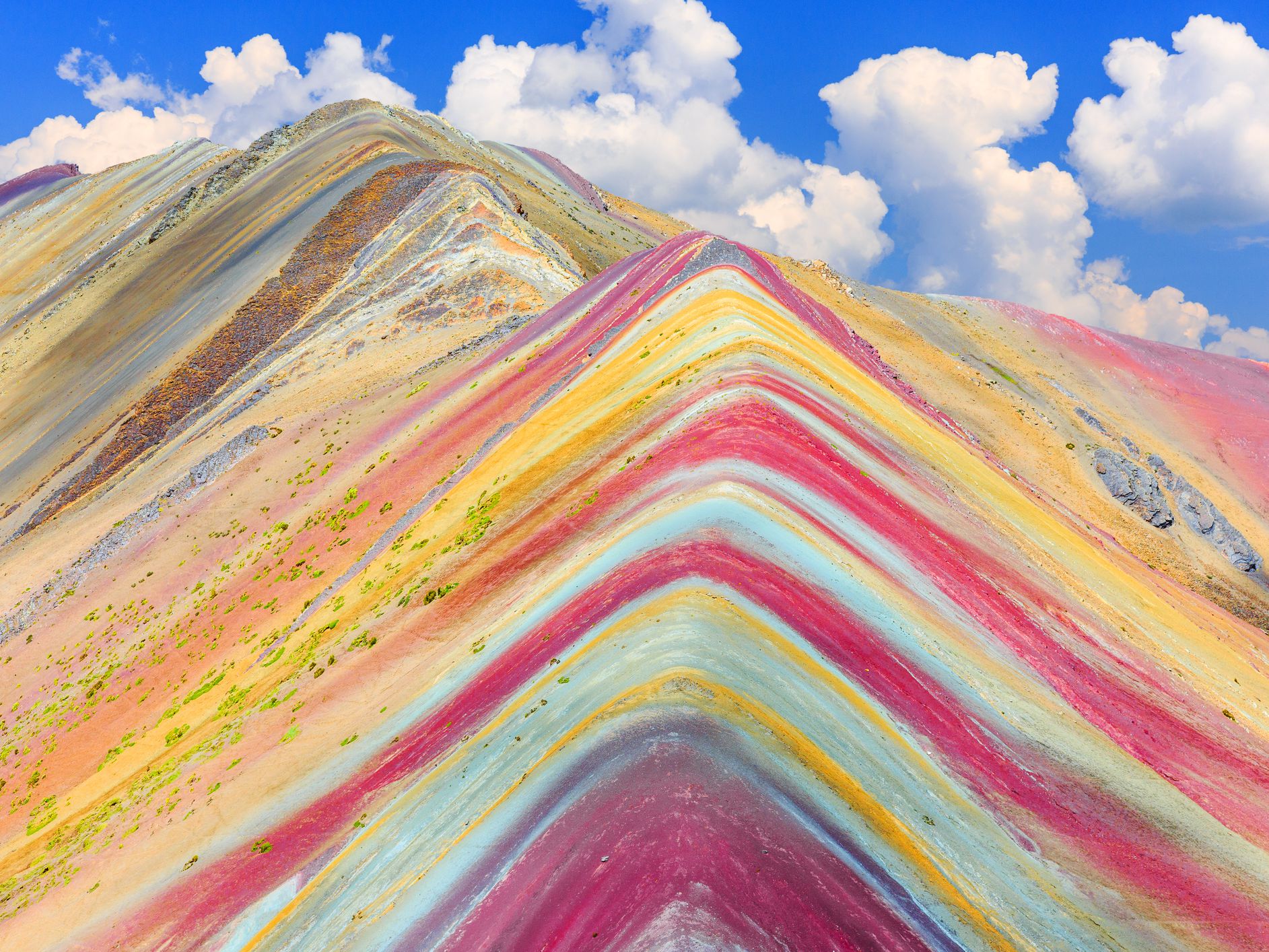
The Rainbow Mountain of Peru. According to the Cultural Landscape Office of the Decentralization of the City of Cusco, the seven colors of the mountain are due to its mineralogical composition: the pink color is due to red clay, fangolitas (mud) and arilitas (sand); the whitish colouring is due to quartzose, sandstone and marls, rich in calcium carbonate; the red is due to claystones (iron) and clays belonging to the Upper Tertiary period; the green is due to phyllites and clays rich in ferro magnesian; the earthy brown is a product of fanglomerate composed of rock with magnesium belonging to the Quaternary period; and the mustard yellow color comes from the calcareous sandstones rich in sulphurous minerals.

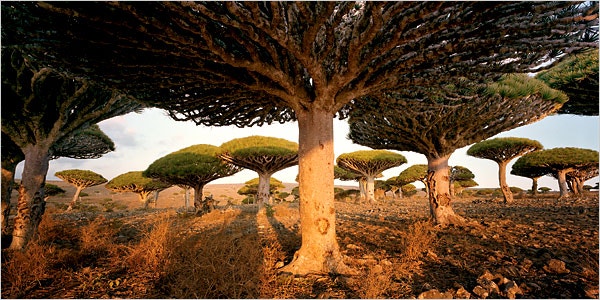
Dracaena cinnabari or dragon blood tree. A tree from the Wonder Land of Socotra, Yemen. Socotra is considered the jewel of biodiversity in the Arabian Sea.
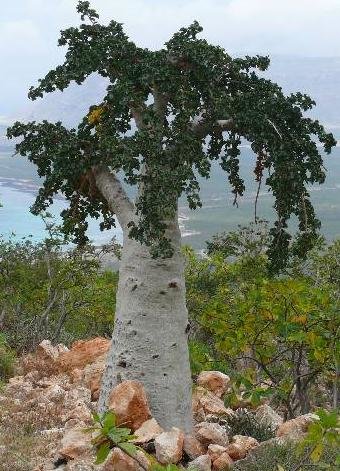
Dendrosicyos or the cucumber tree. Also native to Socotra, Yemen.

Spotted Lake. It is located in Similkameen Valley in British Columbia, Canada. The lake contains dense deposits of magnesium sulfate, calcium and sodium sulphates, and high concentrations of eight other minerals and lower amounts of silver and titanium. Most of the water in the lake evaporates over the summer, revealing colourful mineral deposits.
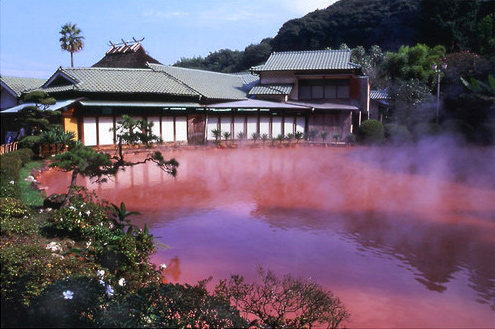
The Blood Pond Hell. One of 'eight hells of Beppu,' a series of hot springs intended for viewing rather than bathing. It's a geothermal pool that's naturally red due to its mineral content such as hematite, a type of iron.
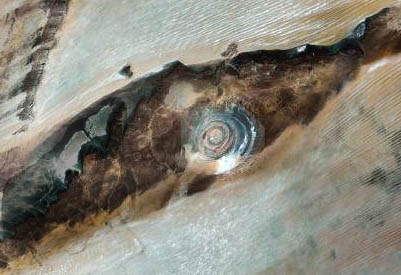
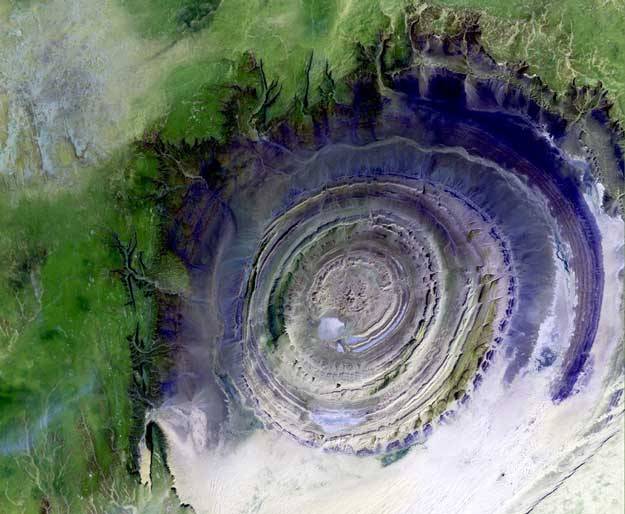
The Eye of Earth. Also known as the Richat Structure. It is a prominent circular feature in the middle of the Sahara Desert of West-Central Mauritania. It is deeply eroded, and stretches 40 km in diameter.

The Eisriesenwelt (German for "World of the Ice Giants") is a natural limestone and ice cave located in Werfen, Austria.
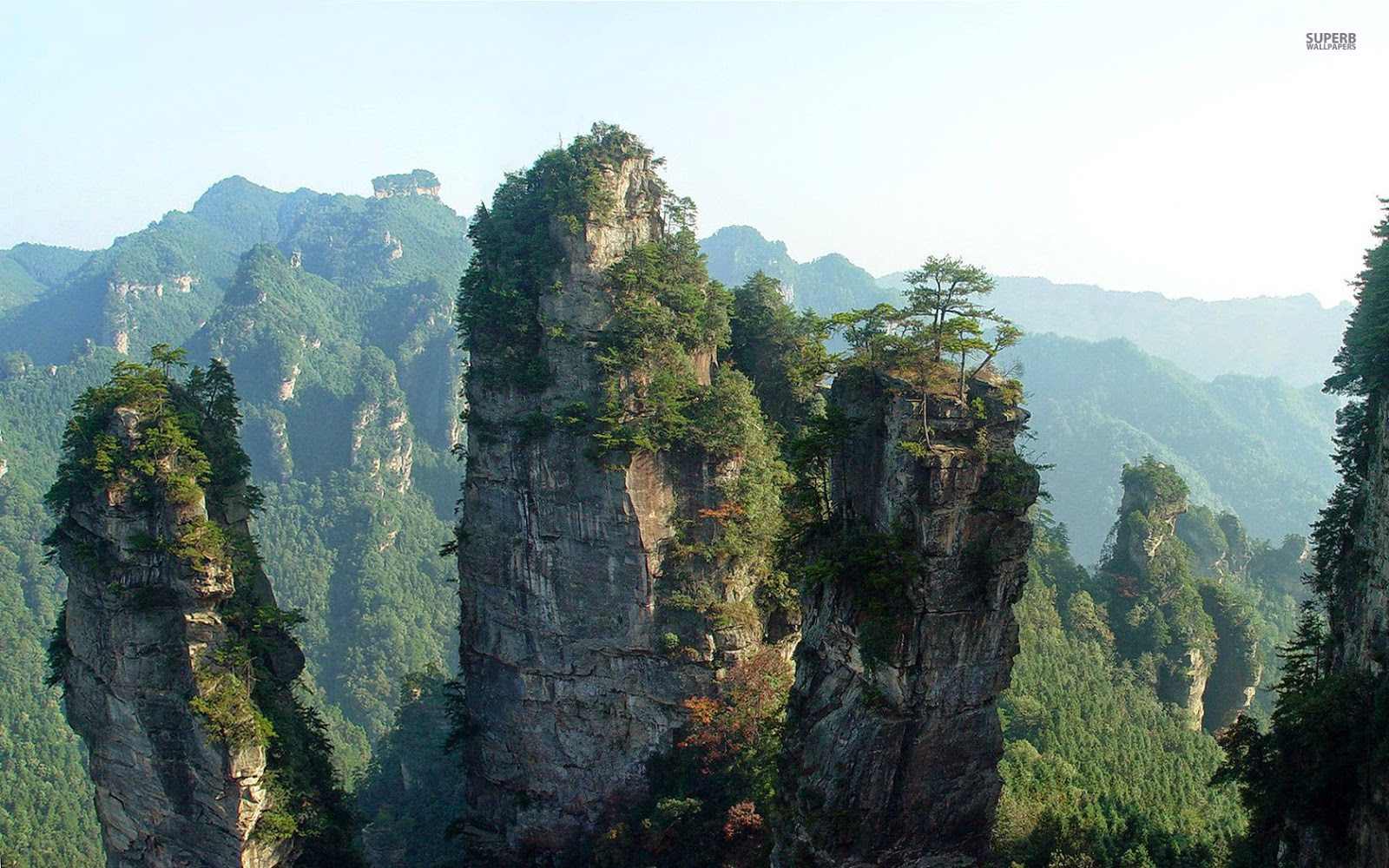
Tianzi Mountain is a mountain located in Zhangjiajie, in the Hunan Province of China. It contains multiple high pillars that look like strange mountains.
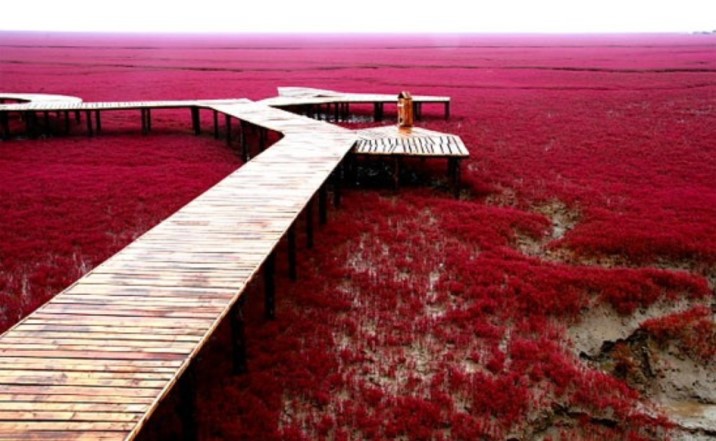
Red Beach. Dawa County, Panjin, China, is famous for its landscape featuring the red plant of Suaeda salsa, of the family Chenopodiaceae.
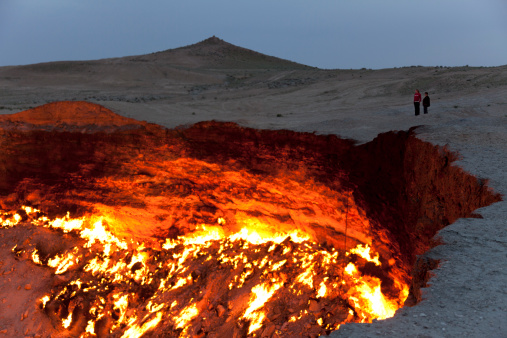
The Door To Hell. Also known as The Darvaza gas crater or Gates of Hell, it is a natural gas field collapsed into a cavern located in Derweze, Turkmenistan.

The Chocolate Hills in the Philippines are covered in green grass that turns brown during the dry season, hence the name.
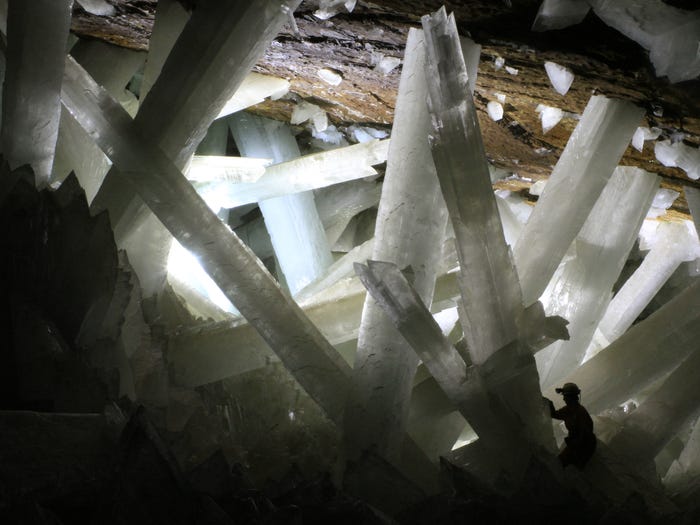
The Cave of the Crystals in Naica, Chihuahua, Mexico. The main chamber contains giant selenite crystals, some of the largest natural crystals ever found.
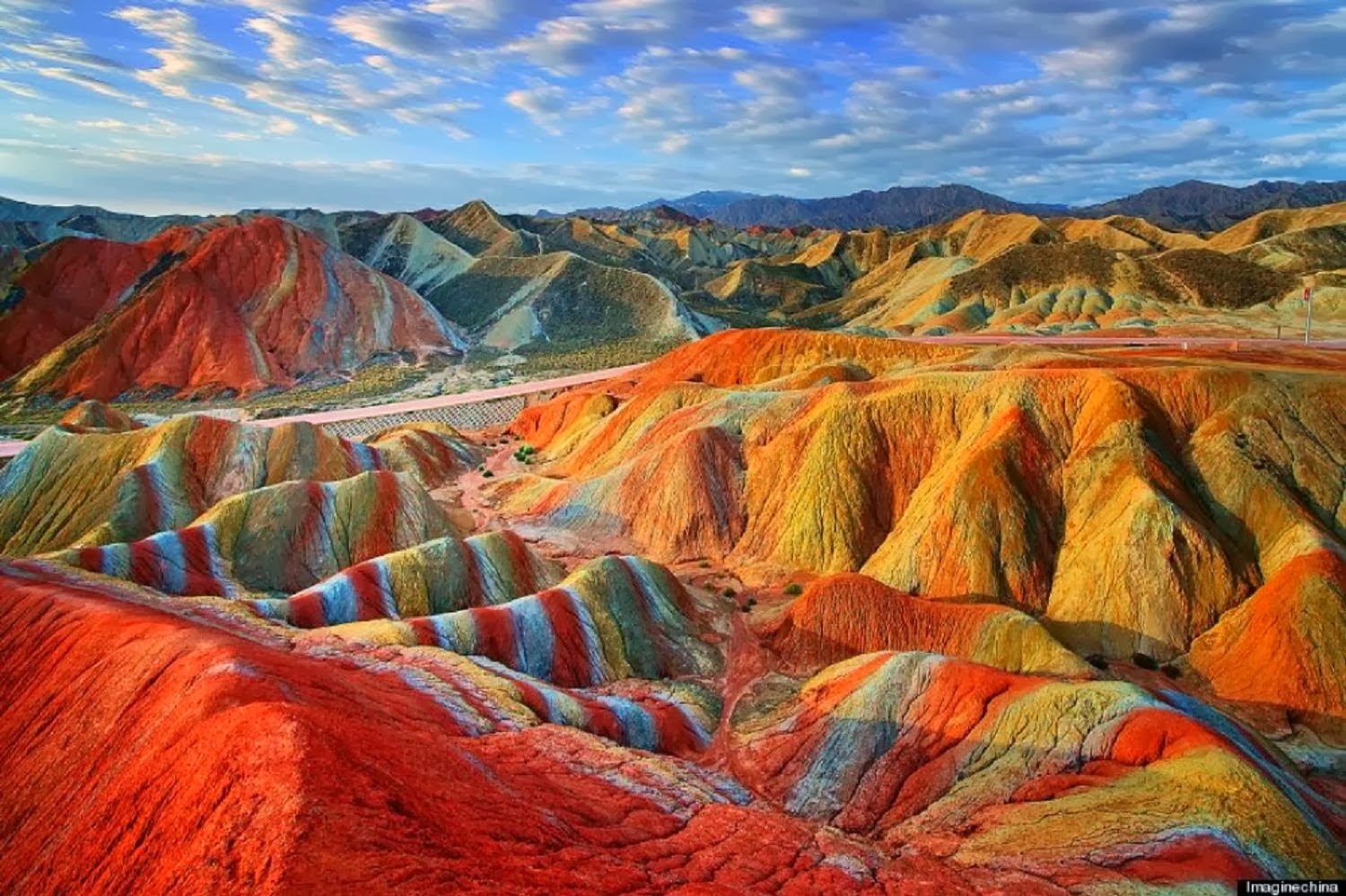
The Zhangye National Geopark is located in Sunan and Linze counties within the prefecture-level city of Zhangye, in Gansu, China. Zhangye Danxia is known for the unusual colours of the rocks, which are smooth, sharp and several hundred meters tall. They are the result of deposits of sandstone and other minerals that occurred over 24 million years. The result (similar to a layer cake), was tilted by the action of the same tectonic plates responsible for creating parts of the Himalayan mountains. Wind, rain, and time then sculpted extraordinary shapes, including towers, pillars, and ravines, with varying colours, patterns, and sizes.
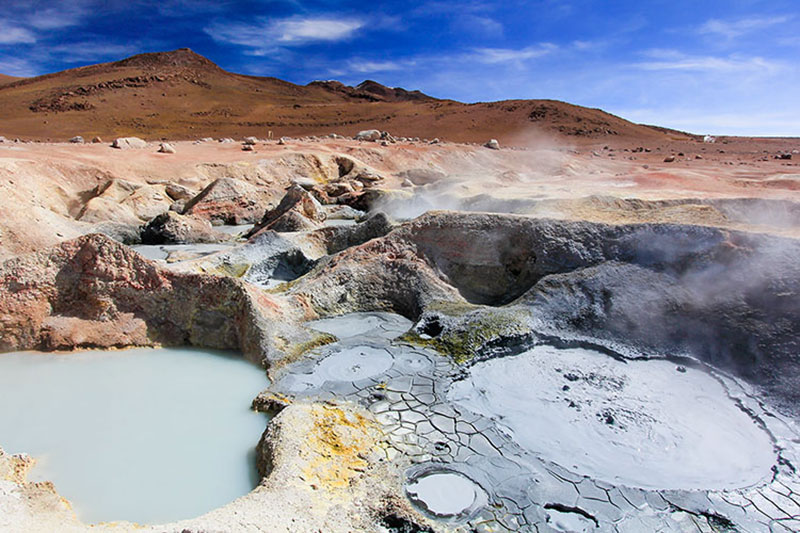
Sol de Mañana is a geothermal area in Sur Lípez Province in the Potosi Department of south-western Bolivia.This area is characterized by intense volcanic activity and the sulphur springs field is full of mud lakes and steam pools with boiling mud.
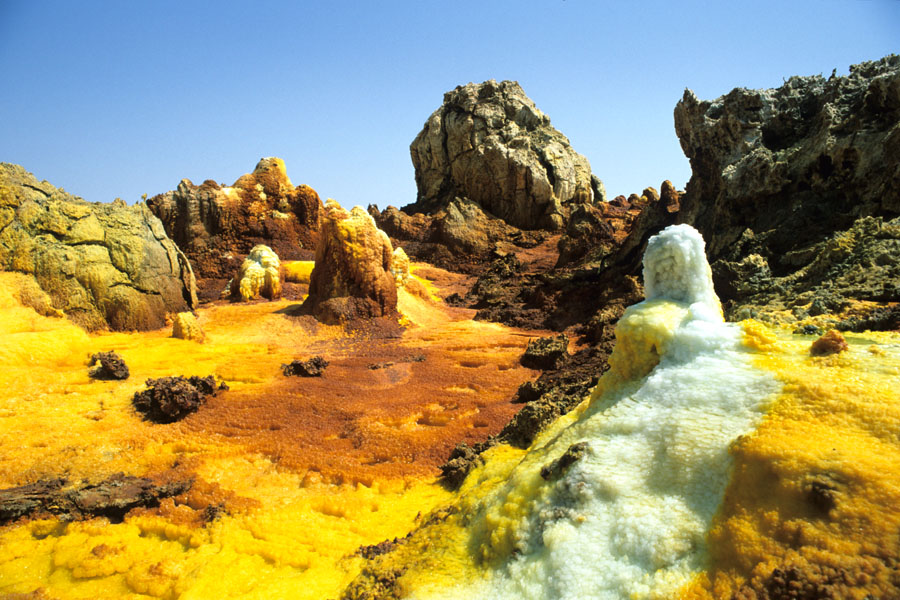
Finally...Dallol. It is a cinder cone volcano in the Danakil Depression, northeast of the Erta Ale Range in Ethiopia. It was formed by the intrusion of basaltic magma into Miocene salt deposits and subsequent hydrothermal activity. Phreatic eruptions took place here in 1926, forming Dallol Volcano; numerous other eruption craters dot the salt flats nearby. These craters are the lowest known subaerial volcanic vents in the world, at 45 m (150 ft) or more below sea level.
More pics of Dallol:
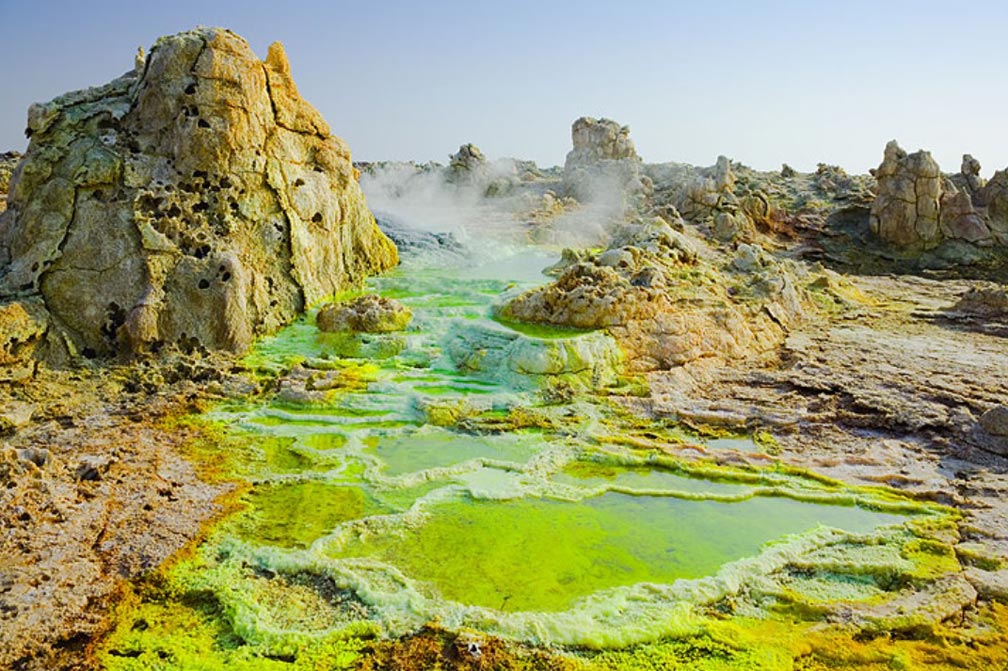
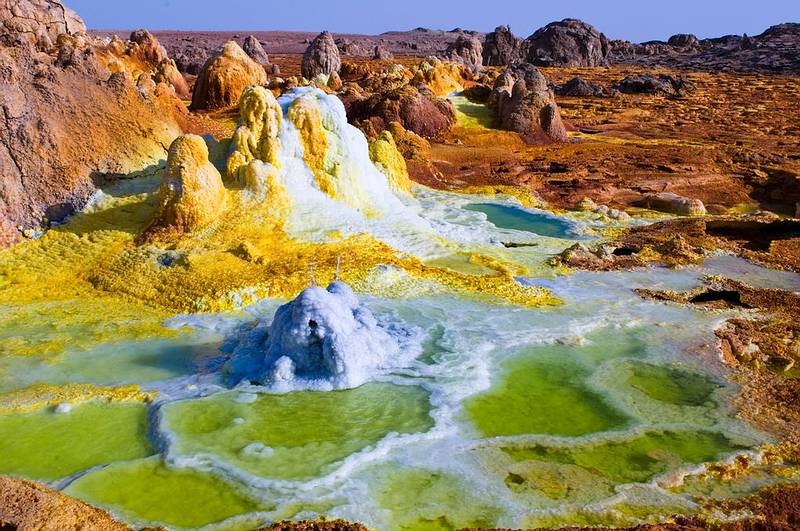
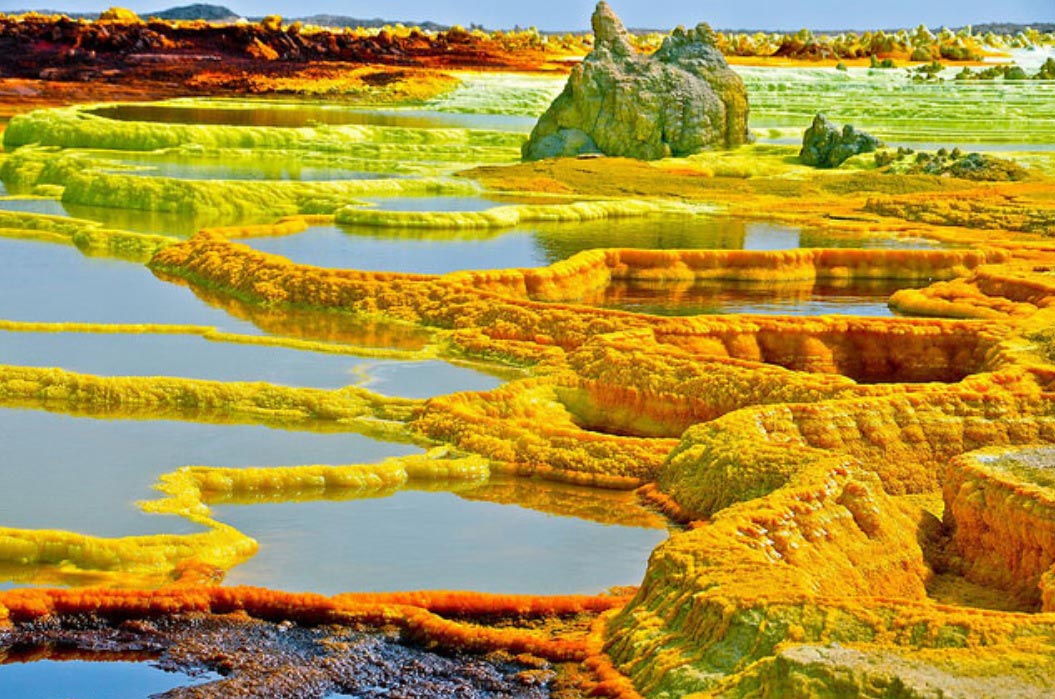
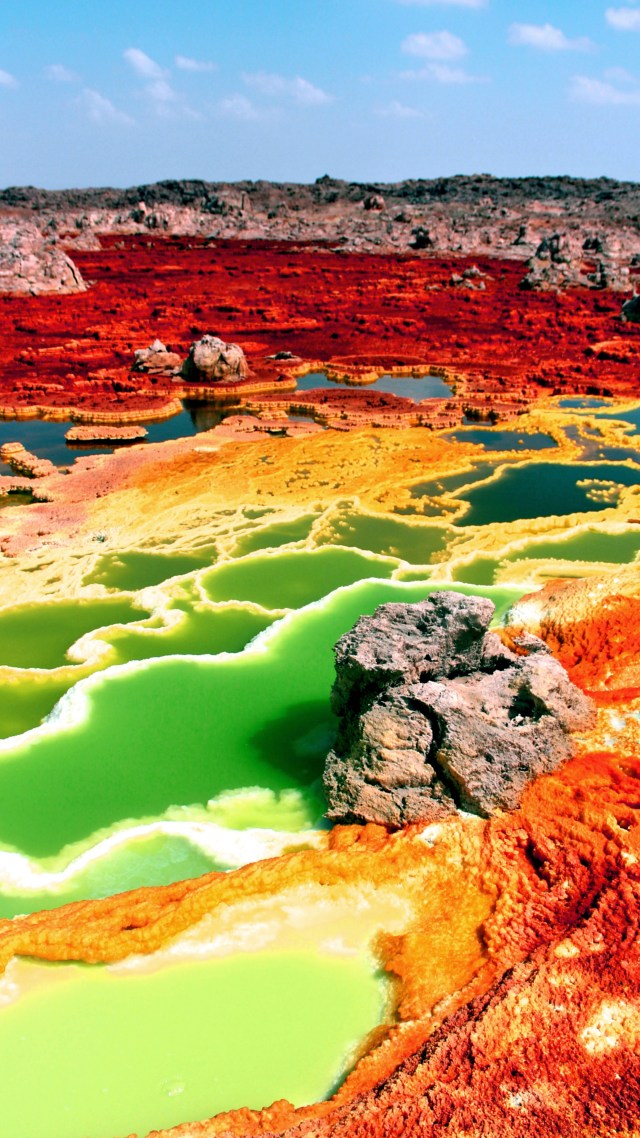
Video footage of Dallol:
www.youtube.com...

The Rainbow Mountain of Peru. According to the Cultural Landscape Office of the Decentralization of the City of Cusco, the seven colors of the mountain are due to its mineralogical composition: the pink color is due to red clay, fangolitas (mud) and arilitas (sand); the whitish colouring is due to quartzose, sandstone and marls, rich in calcium carbonate; the red is due to claystones (iron) and clays belonging to the Upper Tertiary period; the green is due to phyllites and clays rich in ferro magnesian; the earthy brown is a product of fanglomerate composed of rock with magnesium belonging to the Quaternary period; and the mustard yellow color comes from the calcareous sandstones rich in sulphurous minerals.


Dracaena cinnabari or dragon blood tree. A tree from the Wonder Land of Socotra, Yemen. Socotra is considered the jewel of biodiversity in the Arabian Sea.

Dendrosicyos or the cucumber tree. Also native to Socotra, Yemen.

Spotted Lake. It is located in Similkameen Valley in British Columbia, Canada. The lake contains dense deposits of magnesium sulfate, calcium and sodium sulphates, and high concentrations of eight other minerals and lower amounts of silver and titanium. Most of the water in the lake evaporates over the summer, revealing colourful mineral deposits.

The Blood Pond Hell. One of 'eight hells of Beppu,' a series of hot springs intended for viewing rather than bathing. It's a geothermal pool that's naturally red due to its mineral content such as hematite, a type of iron.


The Eye of Earth. Also known as the Richat Structure. It is a prominent circular feature in the middle of the Sahara Desert of West-Central Mauritania. It is deeply eroded, and stretches 40 km in diameter.

The Eisriesenwelt (German for "World of the Ice Giants") is a natural limestone and ice cave located in Werfen, Austria.

Tianzi Mountain is a mountain located in Zhangjiajie, in the Hunan Province of China. It contains multiple high pillars that look like strange mountains.

Red Beach. Dawa County, Panjin, China, is famous for its landscape featuring the red plant of Suaeda salsa, of the family Chenopodiaceae.

The Door To Hell. Also known as The Darvaza gas crater or Gates of Hell, it is a natural gas field collapsed into a cavern located in Derweze, Turkmenistan.

The Chocolate Hills in the Philippines are covered in green grass that turns brown during the dry season, hence the name.

The Cave of the Crystals in Naica, Chihuahua, Mexico. The main chamber contains giant selenite crystals, some of the largest natural crystals ever found.

The Zhangye National Geopark is located in Sunan and Linze counties within the prefecture-level city of Zhangye, in Gansu, China. Zhangye Danxia is known for the unusual colours of the rocks, which are smooth, sharp and several hundred meters tall. They are the result of deposits of sandstone and other minerals that occurred over 24 million years. The result (similar to a layer cake), was tilted by the action of the same tectonic plates responsible for creating parts of the Himalayan mountains. Wind, rain, and time then sculpted extraordinary shapes, including towers, pillars, and ravines, with varying colours, patterns, and sizes.

Sol de Mañana is a geothermal area in Sur Lípez Province in the Potosi Department of south-western Bolivia.This area is characterized by intense volcanic activity and the sulphur springs field is full of mud lakes and steam pools with boiling mud.

Finally...Dallol. It is a cinder cone volcano in the Danakil Depression, northeast of the Erta Ale Range in Ethiopia. It was formed by the intrusion of basaltic magma into Miocene salt deposits and subsequent hydrothermal activity. Phreatic eruptions took place here in 1926, forming Dallol Volcano; numerous other eruption craters dot the salt flats nearby. These craters are the lowest known subaerial volcanic vents in the world, at 45 m (150 ft) or more below sea level.
More pics of Dallol:




Video footage of Dallol:
www.youtube.com...
How can anyone not believe that our world is a wonder to behold? Amazing places.... Thank you for sharing! S&F!
a reply to: LoneCloudHopper2
Great pictures , particularly like the Rainbow Mountain of Peru , it's like all the hippies moved there after the 60s.
Groovy man.
Great pictures , particularly like the Rainbow Mountain of Peru , it's like all the hippies moved there after the 60s.
Groovy man.
edit on 14-9-2020 by gortex because: spelling
a reply to: LoneCloudHopper2
Fascinating and breath taking! Wow!!!!!!! Our planet is so diverse and wondrous.
Fascinating and breath taking! Wow!!!!!!! Our planet is so diverse and wondrous.
originally posted by: LoneCloudHopper2
I've been looking for the most alien-looking places on earth for inspiration for a science fantasy novel idea I've been developing. Some of these discoveries are so wild, I thought I'd share them.
The Rainbow Mountain of Peru. According to the Cultural Landscape Office of the Decentralization of the City of Cusco, the seven colors of the mountain are due to its mineralogical composition: the pink color is due to red clay, fangolitas (mud) and arilitas (sand); the whitish colouring is due to quartzose, sandstone and marls, rich in calcium carbonate; the red is due to claystones (iron) and clays belonging to the Upper Tertiary period; the green is due to phyllites and clays rich in ferro magnesian; the earthy brown is a product of fanglomerate composed of rock with magnesium belonging to the Quaternary period; and the mustard yellow color comes from the calcareous sandstones rich in sulphurous minerals.
Dracaena cinnabari or dragon blood tree. A tree from the Wonder Land of Socotra, Yemen. Socotra is considered the jewel of biodiversity in the Arabian Sea.
Dendrosicyos or the cucumber tree. Also native to Socotra, Yemen.
Spotted Lake. It is located in Similkameen Valley in British Columbia, Canada. The lake contains dense deposits of magnesium sulfate, calcium and sodium sulphates, and high concentrations of eight other minerals and lower amounts of silver and titanium. Most of the water in the lake evaporates over the summer, revealing colourful mineral deposits.
The Blood Pond Hell. One of 'eight hells of Beppu,' a series of hot springs intended for viewing rather than bathing. It's a geothermal pool that's naturally red due to its mineral content such as hematite, a type of iron.
The Eye of Earth. Also known as the Richat Structure. It is a prominent circular feature in the middle of the Sahara Desert of West-Central Mauritania. It is deeply eroded, and stretches 40 km in diameter.
The Eisriesenwelt (German for "World of the Ice Giants") is a natural limestone and ice cave located in Werfen, Austria.
Tianzi Mountain is a mountain located in Zhangjiajie, in the Hunan Province of China. It contains multiple high pillars that look like strange mountains.
Red Beach. Dawa County, Panjin, China, is famous for its landscape featuring the red plant of Suaeda salsa, of the family Chenopodiaceae.
The Door To Hell. Also known as The Darvaza gas crater or Gates of Hell, it is a natural gas field collapsed into a cavern located in Derweze, Turkmenistan.
The Chocolate Hills in the Philippines are covered in green grass that turns brown during the dry season, hence the name.
The Cave of the Crystals in Naica, Chihuahua, Mexico. The main chamber contains giant selenite crystals, some of the largest natural crystals ever found.
The Zhangye National Geopark is located in Sunan and Linze counties within the prefecture-level city of Zhangye, in Gansu, China. Zhangye Danxia is known for the unusual colours of the rocks, which are smooth, sharp and several hundred meters tall. They are the result of deposits of sandstone and other minerals that occurred over 24 million years. The result (similar to a layer cake), was tilted by the action of the same tectonic plates responsible for creating parts of the Himalayan mountains. Wind, rain, and time then sculpted extraordinary shapes, including towers, pillars, and ravines, with varying colours, patterns, and sizes.
Sol de Mañana is a geothermal area in Sur Lípez Province in the Potosi Department of south-western Bolivia.This area is characterized by intense volcanic activity and the sulphur springs field is full of mud lakes and steam pools with boiling mud.
Finally...Dallol. It is a cinder cone volcano in the Danakil Depression, northeast of the Erta Ale Range in Ethiopia. It was formed by the intrusion of basaltic magma into Miocene salt deposits and subsequent hydrothermal activity. Phreatic eruptions took place here in 1926, forming Dallol Volcano; numerous other eruption craters dot the salt flats nearby. These craters are the lowest known subaerial volcanic vents in the world, at 45 m (150 ft) or more below sea level.
More pics of Dallol:
Video footage of Dallol:
www.youtube.com...
The Eye of the Earth is Atlantis.
originally posted by: CIAGypsy
How can anyone not believe that our world is a wonder to behold? Amazing places.... Thank you for sharing! S&F!
Agreed, because it is real in perception, had those photographic pictures, regardless of provenance and methodology, been simply painted as pictoral geographic in the perhaps, not so distant past, how would they have been considered by those never able to see the real thing, nor have access to the science in explanation...would it have been 'fake news' ?
Great pictures OP!
edit on 14-9-2020 by smurfy because: Text.
a reply to: LoneCloudHopper2

That is one of the most incredible images I have ever seen.
Mars needs to up it's game.

That is one of the most incredible images I have ever seen.
Mars needs to up it's game.
double post.
edit on 15-9-2020 by LoneCloudHopper2 because: (no reason given)
a reply to: Wide-Eyes
Eye the Sahara.
Red, Black and White Stone's used in local dry stone construction.
It is indeed a pretty alien landscape to most of us but people actually live there despite it being desert and hostile.
It's not fair on the man's channel to just post his videos one after another here so I urge anyone interested in what he found while visiting the region to pay his channel a visit and look at his video's.
www.youtube.com...
There are however other possible locations for Atlantis and indeed we tend to mix up many flood myth's with the topic when in fact there were and probably will be in the future many Atlantis type disasters.
And were more alien than the bed of the ocean.
Not Atlantis but certainly something any star wars fan of sunken alien city's will love.
And knowing it was probably built by human's when human's were supposedly incapable of such a feat is just icing on the cake.
We know so very little of our own planet.
Vast cavern's in the mantle of the earth could hold almost anything though if life has somehow reached these places it will most likely be extremophile chemosynthetic life.
And there is an ocean deep beneath the surface of the planet many times larger than the ocean on the surface of the planet, mostly it is locked up in a mineral form but still, fountains of the deep.
Eye the Sahara.
Red, Black and White Stone's used in local dry stone construction.
It is indeed a pretty alien landscape to most of us but people actually live there despite it being desert and hostile.
It's not fair on the man's channel to just post his videos one after another here so I urge anyone interested in what he found while visiting the region to pay his channel a visit and look at his video's.
www.youtube.com...
There are however other possible locations for Atlantis and indeed we tend to mix up many flood myth's with the topic when in fact there were and probably will be in the future many Atlantis type disasters.
And were more alien than the bed of the ocean.
Not Atlantis but certainly something any star wars fan of sunken alien city's will love.
And knowing it was probably built by human's when human's were supposedly incapable of such a feat is just icing on the cake.
We know so very little of our own planet.
Vast cavern's in the mantle of the earth could hold almost anything though if life has somehow reached these places it will most likely be extremophile chemosynthetic life.
And there is an ocean deep beneath the surface of the planet many times larger than the ocean on the surface of the planet, mostly it is locked up in a mineral form but still, fountains of the deep.
new topics
-
Outgoing President BARACK OBAMA - Secret Cryptic Call to the News Media on 1.17.2016.
Dissecting Disinformation: 3 hours ago -
Austin sends Fighter Squadrons, Tanker Aircraft to the Middle East
World War Three: 11 hours ago -
Diddy's ex Jennifer Lopez urges Americans to trust her about Kamala Harris
Jokes, Puns, & Pranks: 11 hours ago
top topics
-
CNN now has a pay wall
Other Current Events: 17 hours ago, 14 flags -
Pentagon announces new military aid package for Ukraine
World War Three: 17 hours ago, 14 flags -
Trump thinks Liz Cheaney should be shot in the face?
US Political Madness: 13 hours ago, 14 flags -
Concerning data with regards to Turbo Cancer
Diseases and Pandemics: 12 hours ago, 10 flags -
Diddy's ex Jennifer Lopez urges Americans to trust her about Kamala Harris
Jokes, Puns, & Pranks: 11 hours ago, 8 flags -
Austin sends Fighter Squadrons, Tanker Aircraft to the Middle East
World War Three: 11 hours ago, 6 flags -
Outgoing President BARACK OBAMA - Secret Cryptic Call to the News Media on 1.17.2016.
Dissecting Disinformation: 3 hours ago, 2 flags
active topics
-
Steal the vote alive and well
2024 Elections • 29 • : UKTruth -
Outgoing President BARACK OBAMA - Secret Cryptic Call to the News Media on 1.17.2016.
Dissecting Disinformation • 2 • : Athetos -
Who would you invite to a historical dinner party?
General Chit Chat • 19 • : Freeborn -
Tucker Carlson Shares Amazing Story: "I Was Mauled By a Demon"
Paranormal Studies • 37 • : bastion -
Pentagon announces new military aid package for Ukraine
World War Three • 15 • : Dalamax -
True Voter Surpression and an attack on a voter in North Carolina
US Political Madness • 68 • : JadedGhost -
Betting markets have Trump by a good bit
2024 Elections • 91 • : UKTruth -
Trump thinks Liz Cheaney should be shot in the face?
US Political Madness • 64 • : JadedGhost -
Concerning data with regards to Turbo Cancer
Diseases and Pandemics • 14 • : tarantulabite1 -
Chinese citizen charged after allegedly voting illegally in key battleground state;
2024 Elections • 27 • : confuzedcitizen
